
Ostropol, Ukraine
Stary Ostropil , Ostropolya, Ostropolia, אסטראפאער (Yiddish), Старий Острополъ (Ukr), Старый Острополъ (Rus)
Deborah Sheppard Visit to Ostropol
July 26, 2008
Our trip was arranged by Solaway Travel, an agency based in Vancouver, BC. The Ukrainian Embassy in Toronto had recommended them to us as being very experienced in "roots" trips, and they were outstanding. They made all the travel and accommodation arrangements with guided tours in Lviv and Kiev. Most importantly, we had an excellent driver and translator to take us to the two shtetls and help us find our way. People do not speak English and the road signs are in Cyrillic: one would have to be very adventurous to travel without assistance.
After a day in Lviv, we headed for Rivne, (in Yiddish - Rovno). Since the shetls have very little infrastructure, we needed to stay in Rivne and drive out to the shtetls each day, then return to Rivne at night.

Figure 1 Road signs to Berdichev and Zhitomir
On July 26, we set out early for Ostropol, a three-hour drive away. Good weather and lots of beautiful vistas of open fields and shaded roads through small settlements. The houses and lots are very close to the road. Single cows, horses, goats, chickens, and geese all graze on the verge. People of all ages ride by slowly on bicycles. The paved road has two lanes, and needs repair. There are not many cars, but quite a few horse-drawn carts.
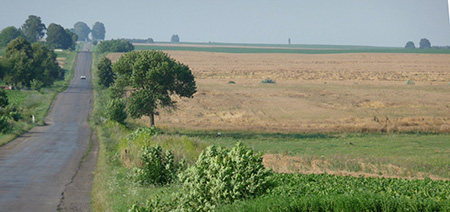
Figure 2: On the road to Ostropol
We pass occasional small commercial buildings, gas stations, a factory here and there, along with relics of the communal farms of the Soviet era. There are also occasional bus shelters, some quite beautifully tiled with mosaics.
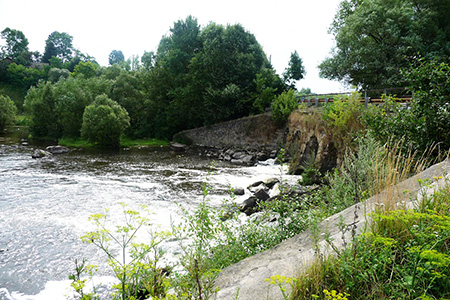
Figure 3: The River Slucz at Ostropol
At the outsksirts of Ostropol, we crossed the river Slucz (Ruslan, our driver, told me to pronounce it "Slootch"). It was very lovely, and I was thrilled to see the site of many stories of my grandfather David Echenberg, who had been a champion speed skater in his youth and had raced on the Slucz, leaping over long rows of barrels.
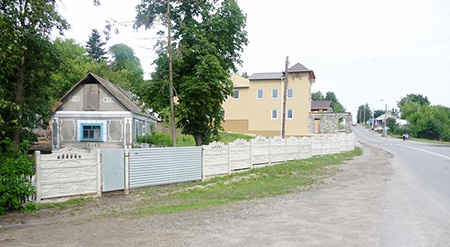
Figure 4: Ostropol's one main street
just as you cross the bridge into town.
Ostropol proper consists of one main road, which passes through the town. There is the City Hall, covered in pastel-painted stucco, a store, and a square, which has a restaurant/bar building that is not operational. There were few people about, and the town looks as though it belongs to a bygone era. Except for the store, there were no commercial or industrial structures visible. It is difficult to imagine how the residents support themselves. All the homes we passed have vegetable gardens and fruit and nut trees, with perhaps some chickens, a cow or a couple of goats. It seems clear that they need to supply a significant portion of their food supply by growing or raising it. There is electricity but no sewage system or running water. There are public water pumps here and there along the side dirt roads. There is no phone service, but everyone seems to have mobile phones. There were very few cars or other vehicles in evidence.
We knew from Ruslan that we would find no records or archives of Ostropol's Jewish past. He told us that such archives would have been housed in the synagogues, which had destroyed.
We had learned from Dean Echenberg and from Sharon Weinstein, both of who had previously visited Ostropol, that there was one Jewish resident remaining, Anatoly Polonski and his Ukrainian wife, Katya. We wanted very much to meet him.
We encountered a group of women apparently returning from church. They all wore babushkas and carried bags of one sort or another. Ruslan asked the women where we might find the Polonskis, and they directed us to the road where we would find their house. One of the women called Katya on her cell phone, and we learned that Anatoly was not well and was in the local hospital. This was dismaying news. We weren't sure how to proceed, but after a short while a woman came hurrying up the muddy dirt road. Ruslan was sure that she must be Katya.
She had been told that there were "Americans" waiting for her, and she assumed that it would be Dean and was somewhat confused to find us instead. I told her that I was Dean's cousin, and we embraced.
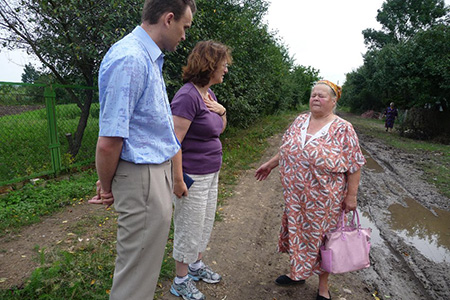
Figure 5 Meetings with Katya Polonsky
Anatoly had been in the hospital since the previous day. The humidity affects his heart condition. Katya said that his face was as purple as my shirt, but that today he was feeling better.
She took us through their garden to the Jewish cemetery, which is immediately next to their house. Anatoly has been trying to clear the area and keep it from being completely overgrown, but this was becoming more difficult as he gets older, especially with his heart condition. I had learned from Sharon Weinstein's account from her visit here in 2001, that Anatoly’s uncle had been the prior custodian of the cemetery and the engraver of the Hebrew letters on the headstones – he had been killed by the Nazis in 1942. It was deeply moving to be here, among my ancestors. Neither Tom nor I read Hebrew, so could not make out the inscriptions on the very weathered headstones. There was an especially beautiful cluster of headstones under a walnut tree.
This is the "new" cemetery. The "old" cemetery is across the road in an open field. There are very few headstones left, almost all of them fallen, the inscriptions often invisible. There is a new small white memorial with a plaque marking the grave of a tzaddick, "Shimshon." A man who lives nearby said that some men installed it a year ago June.
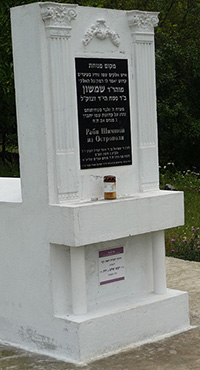
Figure 6: New monument
to Shimshom of Ostropol
Katya insisted on feeding us something, despite our protestations. Their home is very humble, lots of small outbuildings and sheds with woodpiles, tools, a bowl of peas drying in the sun. Their main living area is a windowed porch facing the large garden. Two single beds are at right angles in the far corner. There is a table, small pieces of furniture, cabinets, etc. There is electricity but no running water or bathroom. There are two outhouses adjacent to the house. There is a public water pump on the road close to their house.
Katya made coffee - a thick, sludgy drink, and served us sliced bread and butter and delicious tomatoes. She told us about the family, her children and Anatoly's children. This was a second marriage; they had been together for about 25 years.
Then Katya took us to visit Anatoly in the hospital.
Visiting Anatoly Polunsky

Figure 7: Visiting Anatoly in the hospital.
The building did not match our North American expectations of "hospital". It was a three-story building without any real treatment facilities that we could see. Patients come here when they need some degree of medical oversight, provided by nursing staff. Patients need to supply all their own medications.
It made me think of the old days when patients might be sent to the hospital "for a rest" - it did not appear that there was much of anything else available here. We found Anatoly's large room, which he shared with three other male patients. There was a single (non-hospital) bed and a nightstand in each corner of the room. This hospital did have running water and sewer service, but I observed that the bathroom on the ward was the dirtiest I saw during our entire visit to Ukraine.
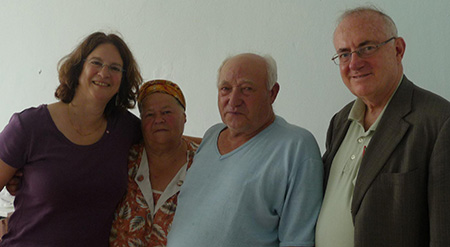
Figure 8: Deborah, Katya, Anatoly and Tom
Anatoly was glad to meet us, and spoke very warmly of his visits with Dean and Sharon. He was clearly tired and not feeling well, so we did not stay long or burden him with too many questions (of which we had many). It was apparent that the costs of his medications were a problem, so we left him with money to help defray the costs. It was a very moving visit with the last Jewish resident of Ostropol. We then left on our three-hour return trip to Rivne. I was filled with images of Ostropol and the task of trying to reconcile our experience of this poor village with the stories of the bustling Ostropol of yesteryear.








